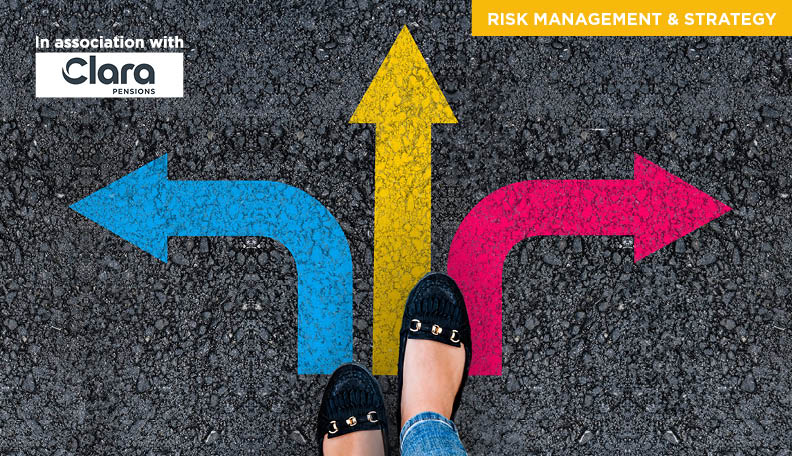
There are still more than 5,000 corporate defined benefit (DB) schemes left in the UK. While the vast majority are closed to either new members or future accrual and hence retain little utility to their sponsoring company, their liabilities remain stubbornly on the corporate balance sheet.
Until recently, companies faced a binary choice in managing this risk. Offloading part or all of the scheme to an insurer via a ‘buy-in’ or ‘buy-out’ presented a one-time solution to this problem, albeit one only available to those schemes sufficiently well-funded or with a sponsor with deep enough pockets.
For the rest, unable to afford the additional capital to top up their scheme to the level required for buy-in or buy-out, the only option was to retain the pension risk on the balance sheet. And then work with the scheme’s trustees to reach a point where the insurance route became viable in time.
In 2016, the Pensions and Lifetime Savings Association (PLSA) launched a taskforce with two aims: to consider how to better secure the future of legacy DB schemes, and to reduce or remove their risk from corporate balance sheets. Among the conclusions was the idea that scheme risk could be countered through the creation of new vehicles that consolidated corporate DB schemes and removed them from the corporate balance sheet.
This idea, quickly labelled as pension “superfunds”, was endorsed by the taskforce’s final report in 2017. Soon afterwards, the first two superfunds – Clara-Pensions and the Pension Superfund – were created.
Clara has since gone on to execute the UK’s first three transactions, most recently with the multi-billion-pound construction and property services business, the Wates Group. This latest transaction has materially altered the landscape, demonstrating that a superfund is an accessible and appropriate risk settlement option for an active sponsor. Today, Clara manages the pensions of more than 20,000 people and their almost £1.5bn of assets.
Capital previously tied up in supporting the pension scheme is free to be redeployed into product development, research and innovation, or geographic expansion
The idea behind superfunds like Clara is simple. For companies and schemes that can’t afford to go straight to the insurance market, they offer a more affordable “bridge to buy-out”. To undertake a transaction, the pension fund members are transferred from the existing company pension scheme into a dedicated section of the Clara Pensions Trust – a sectionalised occupational pension scheme overseen by a board of independent, professional trustees.
Capital to support the new section is injected and then ringfenced by Clara, creating a healthy buffer for the scheme, increasing its security and enabling the superfund to manage its assets over time to target an insurance buy-out. In Clara’s case, this capital is provided by its investors, which include global private capital firm Sixth Street.
Once inside a superfund, the scheme benefits from significant economies of scale across investment, governance, and member administration that consolidation can provide. Meanwhile, just as is the case in an insured buy-out, the sponsoring company is freed of its liabilities, leaving it to concentrate on the core business. Capital previously tied up in supporting the pension scheme is free to be redeployed into product development, research and innovation, or geographic expansion.
And in five to 10 years’ time, the “bridge to buy-out” is complete as the scheme is transferred from the superfund to an insurer for the rest of its life. Pension schemes that are suitable for a superfund transaction are typically 85-95% funded, although future innovation is likely to widen this range further.
Superfunds are also mandated to have rigorous governance
At its heart, a superfund is still a defined benefit scheme, with all the rigorous governance, regulation and investment prudence that goes with it. Every superfund has to pass a thorough assessment process with the Pensions Regulator before being given the green light to conduct transactions.
In Clara’s case this was granted in 2021. Individual transactions are also then reviewed by the regulator before proceeding. Indeed, to enter a superfund, a scheme’s trustees have to undertake an assessment to reach a high degree of confidence that members’ pensions will be demonstrably more secure than staying where they are.
Superfunds are also mandated to have rigorous governance. For Clara, this means a board of independent professional trustees made up of some of the longest-serving and most well-respected figures in the pensions industry, as well as an entirely separate group of non-executive directors and chairman of the corporate board. And, should the very worst happen, superfunds are covered by the same rules as any other defined benefit pension scheme, meaning that members can be placed into the care of the Pension Protection Fund.
The first superfund transaction took place in November 2023 when around 10,000 members of the Sears retail pension scheme transferred to Clara. In only 18 months since, two more transactions, including the Wates deal, have taken place, bringing the total to more than 20,000 members benefiting from consolidation. Estimates suggest another two to three transactions will take place this year, with the cadence increasing from there.
The government has also signalled its support, committing to introducing legislation for superfunds that is expected to be laid before parliament later this year. This is likely to lead to several more superfunds being established, creating a wider market for companies to choose from when looking to transfer their pension scheme.
Where once companies faced an uncomfortably difficult binary choice for their legacy DB schemes between continued financial uncertainty or a one-off significant outlay, today the choice is becoming a little broader and a little easier thanks to the rise of superfunds.
Matt Wilmington is chief transactions officer at Clara-Pensions

